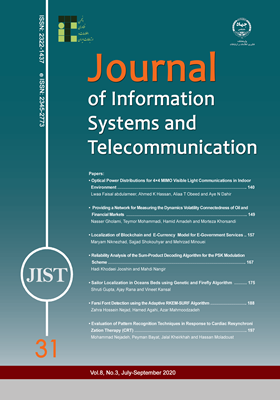-
-
List of Articles
-
Open Access Article
1 - Optical Power Distributions for 4×4 MIMO Visible Light Communications in Indoor Environment
lwaa abdulameer Ahmed Hassan Aliaa T. Obeed Aya N. Dahir -
Open Access Article
2 - Providing a Network for Measuring the Dynamics Volatility Connectedness of Oil and Financial Markets
Nasser Gholami Teymor Mohammadi Hamid Amadeh Morteza Khorsandi -
Open Access Article
3 - Localization of Blockchain and E-Currency Model for E-Government Services
Maryam Niknezhad Sajjad Shokouhyar Mehrzad Minouei -
Open Access Article
4 - Reliability Analysis of the Sum-Product Decoding Algorithm for the PSK Modulation Scheme
Hadi Khodaei Jooshin Mahdi Nangir -
Open Access Article
5 - Sailor Localization in Oceans Beds using Genetic and Firefly Algorithm
Shruti Gupta Dr Ajay Rana Vineet Kansal -
Open Access Article
6 - Farsi Font Detection using the Adaptive RKEM-SURF Algorithm
Zahra Hossein-Nejad Hamed Agahi Azar Mahmoodzadeh -
Open Access Article
7 - Evaluation of Pattern Recognition Techniques in Response to Cardiac Resynchronization Therapy (CRT)
Mohammad Nejadeh Peyman Bayat Jalal Kheirkhah Hassan Moladoust
-
The rights to this website are owned by the Raimag Press Management System.
Copyright © 2017-2025







